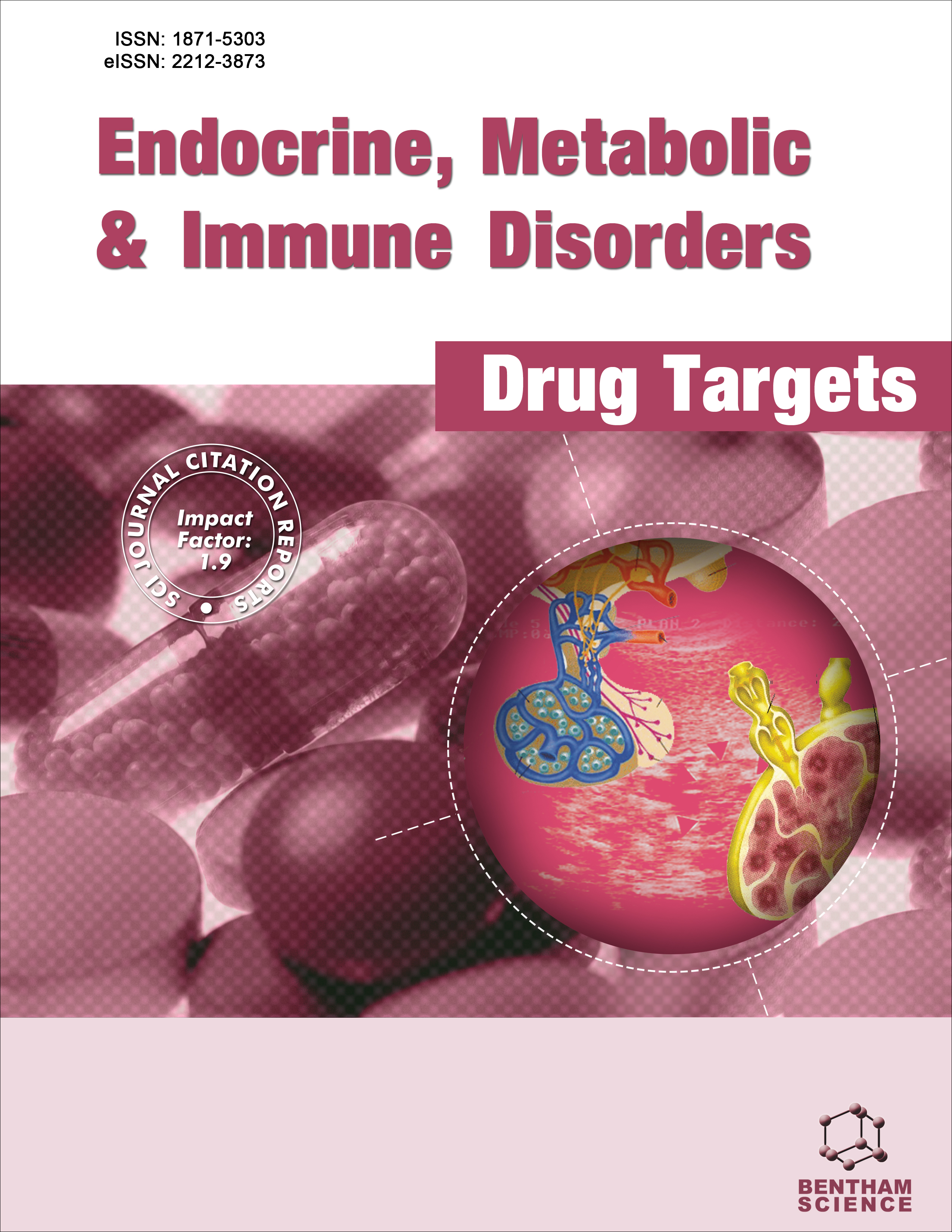- Home
- A-Z Publications
- Endocrine, Metabolic & Immune Disorders-Drug Targets (Formerly Current Drug Targets - Immune, Endocrine & Metabolic Disorders)
- Previous Issues
- Volume 22, Issue 10, 2022
Endocrine, Metabolic & Immune Disorders-Drug Targets (Formerly Current Drug Targets - Immune, Endocrine & Metabolic Disorders) - Volume 22, Issue 10, 2022
Volume 22, Issue 10, 2022
-
-
Vitamin B-related Gene Polymorphisms and Cardiovascular Disease
More LessAuthors: Maria E. Katsa and Andrea P. R. GilHyperhomocysteinemia is an independent risk factor for atherosclerosis, even in early childhood. A mutation in genes that code homocysteine metabolism enzymes or deficiency of specific vitamin cofactors may cause hyperhomocysteinemia. Vitamin B complex has been correlated with serum homocysteine levels. Any abnormality in its metabolism or nutritional deficiency may lead to hyperhomocysteinemia. Both vitami Read More
-
-
-
Role of Dietary Supplements in Thyroid Diseases
More LessAuthors: Vinesh Dahiya, Neeru Vasudeva, Sunil Sharma and Ashok KumarBackground: Thyroid hormones play a vital role in regulating our body’s metabolism. Two important thyroid hormones released from the thyroid gland are tri-iodothyronine (T3) and tetra-iodothyronine (T4). Thyroid-stimulating hormone and thyroid regulating hormone control the T3 and T4 levels in our body. Increased TSH levels indicate hypothyroidism and decreased TSH levels indicate hyperthyroidism. Iodine is a crucial n Read More
-
-
-
The Emerging Roles of IL-36, IL-37, and IL-38 in Diabetes Mellitus and its Complications
More LessAuthors: Guoqing Huang, Mingcai Li, Xiaoqing Tian, Qiankai Jin, Yushan Mao and Yan LiDiabetes mellitus is a metabolic disease caused by a combination of genetic and environmental factors. The importance of the inflammatory response occurring in the pancreas and adipose tissue in the occurrence and progression of diabetes has been gradually accepted. Excess blood glucose and free fatty acids produce large amounts of inflammatory cytokines and chemokines through oxidative stress and endoplasmi Read More
-
-
-
Pathogenic Roles of m6A Modification in Viral Infection and Virus-driven Carcinogenesis
More LessAuthors: Jia-Feng Wang, Wei Cai, Fen-Sheng Qiu and Chen-Huan YuN6-methyladenosine (m6A) is a prevalent modification of RNA in eukaryotes, bacteria, and viruses. It is highly conserved and can affect the structure, localization, and biology functions of RNA. In recent years, multiple m6A methylation sites have been identified in the viral RNA genome and transcripts of DNA viruses. This modification occurs commonly during the primary infection and is dynamically regulated by a methy Read More
-
-
-
Cellular and Molecular Aspects of Managing Familial Hypercholesterolemia: Recent and Emerging Therapeutic Approaches
More LessFamilial hypercholesterolemia (FH) as a high-frequency genetic disorder is diagnosed based on family and/or patient’s history of coronary heart disease (CHD) or some other atherosclerotic diseases, LDL-C levels, and/or clinical signs such as tendinous xanthoma, arcus cornealis before age 45 years as well as a functional mutation in the LDLR, apoB or PCSK9 gene. Its clinical features are detectable since early childhood. Ear Read More
-
-
-
Respiratory Function Correlates with Fat Mass Index and Blood Triglycerides in Institutionalized Older Individuals
More LessAuthors: Francisco M. Martinez-Arnau, Cristina Buigues, Rosa Fonfría-Vivas and Omar CauliBackground: We investigated the relationship between respiratory function measured by spirometry analysis and anthropometric variables (skeletal and fat mass) and nutritional status in the institutionalized elderly, particularly at high-risk for adverse outcomes after respiratory infections and malnutrition. Design: This is a multicenter cross-sectional study with a quantitative approach conducted among older people institutional Read More
-
-
-
Case Report of a Novel NFkB Mutation in a Lymphoproliferative Disorder Patient
More LessBackground: Lymphoproliferative disorders include a heterogeneous list of conditions that commonly involve dysregulation of lymphocyte proliferation resulting in lymphadenopathy and bone marrow infiltration. These disorders have various presentations, most notably autoimmune manifestations, organomegaly, lymphadenopathy, dysgammaglobulinemia, and increased risk of chronic infections. Case Presentation: Read More
-
-
-
Safety and Effectiveness of Compounded Galenic Cholic Acid for Bile Acid Synthesis Disorder: A Case Report
More LessBackground: Bile acid synthesis disorders are rare congenital diseases that can lead to cirrhosis and end-stage liver disease if left untreated. Cholic acid administration is the only treatment that can prevent patients from fatal outcomes. Since 2013 in Europe, there has been just one formulation of cholic acid: Orphacol®. It is difficult to administer to infant patients because of its formulation (capsules) and the need for dose titrati Read More
-
-
-
Effects of Semaglutide on Glycemic Control and Weight Loss in a Patient with Prader-Willi Syndrome: A Case Report
More LessBackground: Prader-Willi syndrome is the most frequent genetic cause of obesity and is often complicated by glucose metabolism alterations. Conventional therapies prescribed for type 2 diabetes frequently failed to achieve adequate glycemic control in patients with Prader-Willi syndrome. Beneficial effects of glucagon like peptide-1 receptor agonists exenatide and liraglutide have been reported for the management of type Read More
-
Volumes & issues
-
Volume 25 (2025)
-
Volume 24 (2024)
-
Volume 23 (2023)
-
Volume 22 (2022)
-
Volume 21 (2021)
-
Volume 20 (2020)
-
Volume 19 (2019)
-
Volume 18 (2018)
-
Volume 17 (2017)
-
Volume 16 (2016)
-
Volume 15 (2015)
-
Volume 14 (2014)
-
Volume 13 (2013)
-
Volume 12 (2012)
-
Volume 11 (2011)
-
Volume 10 (2010)
-
Volume 9 (2009)
-
Volume 8 (2008)
-
Volume 7 (2007)
-
Volume 6 (2006)
Most Read This Month
Article
content/journals/emiddt
Journal
10
5
false
en


